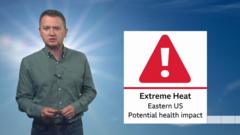Is a Record-Breaking Heatwave Coming to the Eastern US?

Understanding Summer Heatwaves in the US: Risks and Preparedness
As the summer months roll in, the United States faces the inevitability of heatwaves. These periods of extreme heat are not just uncomfortable; they can also be life-threatening. With the forecast predicting potential record-breaking temperatures, understanding the risks associated with heatwaves and how to prepare can mean the difference between safety and danger. This article delves into the science behind heatwaves, their impacts, and essential tips for staying safe during extreme weather conditions.
What is a Heatwave?
A heatwave is typically defined as a prolonged period of excessively hot weather, which may be accompanied by high humidity. Meteorologists often measure heatwaves based on regional temperature averages, with different areas of the U.S. experiencing varying thresholds for what constitutes a heatwave. For instance:
- In the Southeast, temperatures above 90°F (32°C) may trigger heatwave alerts.
- In the Northwest, the threshold might be higher, given the region's cooler climate.
Heatwaves can last from a few days to several weeks, leading to a range of health risks, particularly for vulnerable populations.
Why Are Heatwaves Becoming More Frequent?
Climate change is a significant factor contributing to the increasing frequency and intensity of heatwaves. Factors influencing this trend include:
- Global Warming: Increased greenhouse gas emissions lead to higher global temperatures.
- Urbanization: Cities can create "heat islands" where temperatures are significantly higher than in surrounding rural areas.
- Changed Weather Patterns: Altered jet streams can trap warm air in certain regions, prolonging heatwaves.
The Health Risks Associated with Heatwaves
High temperatures, particularly when combined with humidity, can have severe health effects. The U.S. National Weather Service warns that as temperatures rise, so does the risk of heat-related illnesses, which can include:
Heat Exhaustion
Heat exhaustion occurs when the body loses excessive amounts of water and salt, usually through sweating. Symptoms may include:
- Heavy sweating
- Pale, clammy skin
- Weakness and fatigue
- Dizziness or fainting
Heat Stroke
Heat stroke is a more severe condition that occurs when the body's temperature regulation fails. It can be life-threatening and requires immediate medical attention. Symptoms include:
- High body temperature (104°F or 40°C or higher)
- Altered mental state or confusion
- Hot, dry skin or heavy sweating
- Seizures
Vulnerable Populations
Certain groups are at a higher risk during heatwaves, including:
- The elderly
- Children
- People with chronic illnesses
- Low-income individuals without access to air conditioning
Preparing for a Heatwave
Preparation is crucial for mitigating the health risks associated with heatwaves. Here are several strategies to ensure safety:
Stay Informed
Regularly check weather forecasts and heed any warnings issued by local authorities. Knowing when a heatwave is expected allows for better preparation.
Hydration is Key
Drink plenty of fluids, especially water, to stay hydrated. Avoid alcohol and caffeinated beverages as they can lead to dehydration.
Create a Cool Environment
Keep your living space cool. Here are some tips:
- Use fans or air conditioning.
- Close curtains or blinds during the hottest part of the day.
- Take cool showers or baths.
Limit Outdoor Activities
Avoid strenuous outdoor activities during peak heat hours (generally between 10 a.m. and 4 p.m.). If you must be outside:
- Take frequent breaks in the shade.
- Wear lightweight, loose-fitting clothing.
- Use sunscreen to protect your skin.
Check on Vulnerable Individuals
Reach out to neighbors, particularly the elderly or those with health issues, to ensure they are safe and have access to cool environments.
What to Do During a Heatwave
During an active heatwave, follow these guidelines:
- Monitor your health and that of others closely.
- Seek medical attention if you or someone you know exhibits symptoms of heat-related illnesses.
- Stay indoors as much as possible and keep your home cool.
Conclusion
As summer heatwaves become more common and severe, understanding their risks and knowing how to prepare is essential for protection. By taking proactive steps, staying informed, and looking out for one another, we can navigate these challenging weather conditions safely. The question remains: are we doing enough to prepare ourselves and our communities for the rising temperatures of the future?
Frequently Asked Questions About Heatwaves
What temperature is considered a heatwave?
A heatwave is generally defined as a period of excessively hot weather, which varies by region. In many areas, temperatures above 90°F (32°C) can signal a heatwave.
How can I tell if someone is suffering from heat exhaustion or heat stroke?
Heat exhaustion symptoms include heavy sweating, weakness, and dizziness. In contrast, heat stroke can present with high body temperature, confusion, and dry skin, requiring immediate medical attention.
What are some effective ways to cool down during a heatwave?
Keeping your home cool with fans or air conditioning, drinking plenty of water, taking cool showers, and staying indoors during peak heat hours are effective strategies.
As we brace ourselves for the summer heat, it’s imperative to keep safety as our priority. Are you prepared for the upcoming heatwaves? #HeatwaveSafety #StayCool #SummerPreparedness
Published: 2025-06-23 12:53:07 | Category: wales



